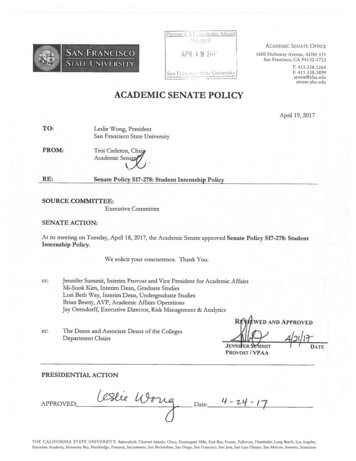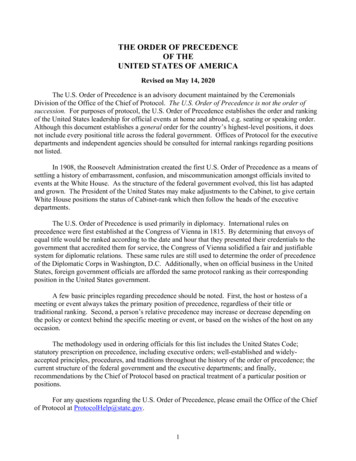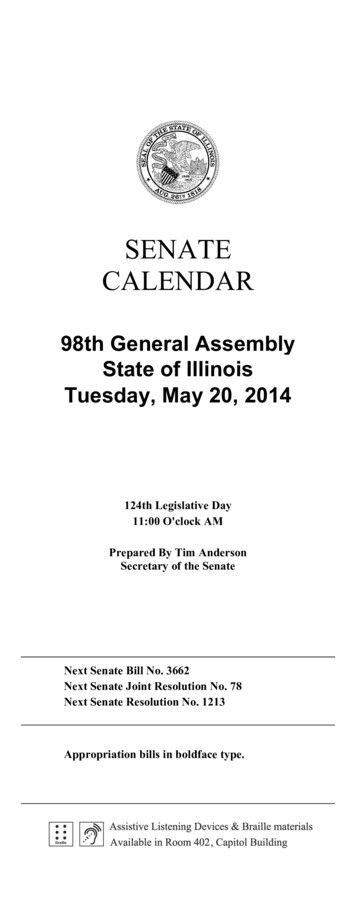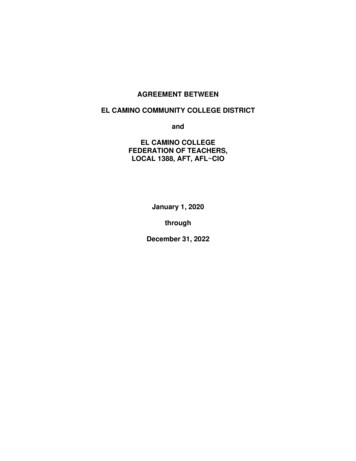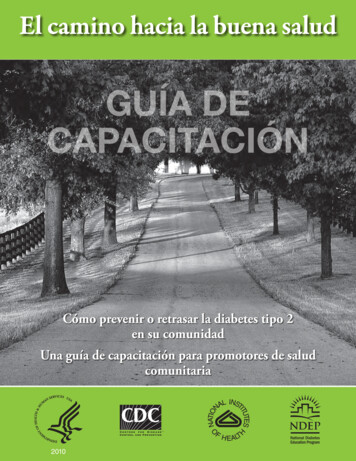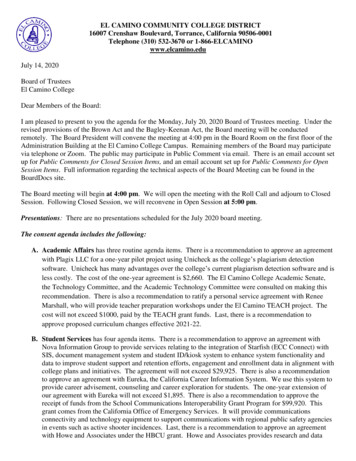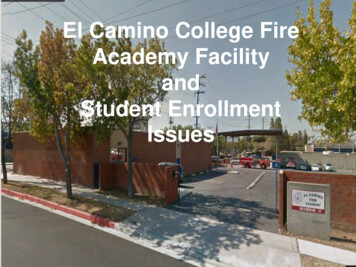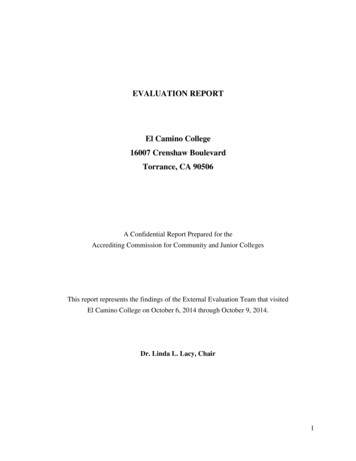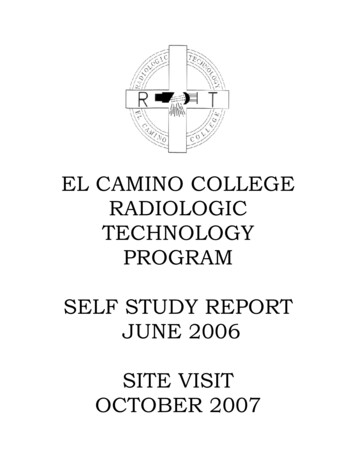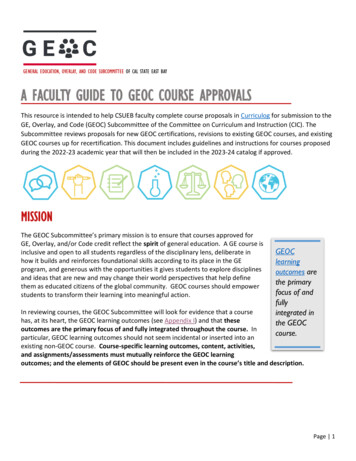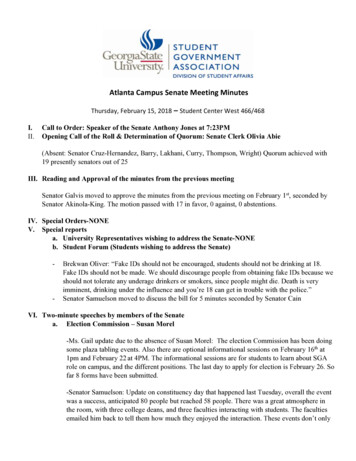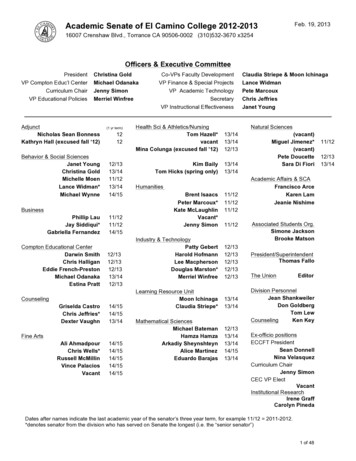
Transcription
Feb. 19, 2013Academic Senate of El Camino College 2012-201316007 Crenshaw Blvd., Torrance CA 90506-0002 (310)532-3670 x3254Officers & Executive CommitteePresidentVP Compton Educ’l CenterCurriculum ChairVP Educational PoliciesChristina GoldMichael OdanakaJenny SimonMerriel WinfreeAdjunctNicholas Sean BonnessKathryn Hall (excused fall ‘12)Behavior & Social SciencesJanet YoungChristina GoldMichelle MoenLance Widman*Michael Wynne(1 yr term)121212/1313/1411/1213/1414/15BusinessPhillip LauJay Siddiqui*Gabriella FernandezCompton Educational CenterDarwin SmithChris HalliganEddie French-PrestonMichael OdanakaEstina elingGriselda CastroChris Jeffries*Dexter Vaughn14/1514/1513/14Fine ArtsAli AhmadpourChris Wells*Russell McMillinVince PalaciosVacant14/1514/1514/1514/1514/15Co-VPs Faculty DevelopmentVP Finance & Special ProjectsVP Academic TechnologySecretaryVP Instructional EffectivenessHealth Sci & Athletics/NursingTom Hazell*vacantMina Colunga (excused fall ’12)13/1413/1412/13Kim BailyTom Hicks (spring only)13/1413/14Natural SciencesHumanitiesBrent IsaacsPeter Marcoux*Kate McLaughlinVacant*Jenny SimonIndustry & TechnologyPatty GebertHarold HofmannLee MacphersonDouglas Marston*Merriel WinfreeClaudia Striepe & Moon IchinagaLance WidmanPete MarcouxChris JeffriesJanet Learning Resource UnitMoon IchinagaClaudia Striepe*13/1413/14Mathematical SciencesMichael BatemanHamza HamzaArkadiy SheynshteynAlice MartinezEduardo Barajas12/1313/1413/1414/1513/14(vacant)Miguel Jimenez*(vacant)Pete DoucetteSara Di FioriAcademic Affairs & SCAFrancisco ArceKaren LamJeanie NishimeAssociated Students Org.Simone JacksonBrooke MatsonPresident/SuperintendentThomas FalloThe UnionEditorDivision PersonnelJean ShankweilerDon GoldbergTom LewCounselingKen KeyEx-officio positionsECCFT PresidentSean DonnellNina VelasquezCurriculum ChairJenny SimonCEC VP ElectVacantInstitutional ResearchIrene GraffCarolyn PinedaDates after names indicate the last academic year of the senator’s three year term, for example 11/12 2011-2012.*denotes senator from the division who has served on Senate the longest (i.e. the “senior senator”)1 of 4811/1212/1313/14
Feb. 19, 2013Academic Senate of El Camino College 2012-201316007 Crenshaw Blvd., Torrance CA 90506-0002 (310)532-3670 x3254SENATE'S PURPOSE (from the Senate Constitution)A. To provide an organization through which the faculty will have the means for full participation inthe formulation of policy on academic and professional matters relating to the college includingthose in Title 5, Subchapter 2, Sections 53200-53206. California Code of Regulations. Specifically,as provided for in Board Policy 2510, and listed below, the “Board of Trustees will normally acceptthe recommendations of the Academic Senate on academic and professional matters of:1. Curriculum, including establishing prerequisites and placing courses within disciplines2. Degree and certificate requirements3. Grading policies4. Educational program development5. Standards and policies regarding student preparation and success6. District and college governance structures, as related to faculty roles7. Faculty roles and involvement in accreditation process, including self-study and annual reports8. Policies for faculty professional development activities9. Processes for program review10. Processes for institutional planning and budget development, and11. Other academic and professional matters as mutually agreed upon between the Board of Trusteesand the Academic Senate.”B. To facilitate communication among faculty, administration, employee organizations, bargainingagents and the El Camino College Board of Trustees.ECC ACADEMIC SENATE MEETING DATES AND LOCATIONS (1st and 3rd Tuesdays)FALL 2012September 6September 18October 2October 16November 6November 20December 4Alondra Room (Canceled)Alondra RoomAlondra RoomAlondra RoomAlondra RoomAlondra RoomAlondra RoomSPRING 2013February 19March 5March 19April 2April 16May 7May 21June 4Alondra RoomAlondra RoomAlondra RoomAlondra RoomAlondra RoomCompton Educational CenterAlondra RoomAlondra RoomCEC ACADEMIC SENATE MEETING DATES AND LOCATIONS (Thursday after ECC Senate, usually)FALL 2012September 6September 20October 4October 18November 1November 15December 6Board RoomBoard RoomBoard RoomBoard RoomBoard RoomBoard RoomBoard RoomSPRING 2013Feb. 21March 7March 21April 4April 18May 2May 16May 30Board RoomBoard RoomBoard RoomBoard RoomBoard RoomBoard RoomBoard RoomBoard Room2 of 48
Academic Senate of El Camino College 2012-2013Feb. 19, 201316007 Crenshaw Blvd., Torrance CA 90506-0002 (310)532-3670 x3254AGENDA & TABLE OF CONTENTSPagesA. CALL TO ORDER (12:30)B. APPROVAL OF MINUTESHandoutC. OFFICER REPORTSA. President – Christina Gold6-14B. VP – Compton Education Center – MichaelOdanaka15-21C. Chair – Curriculum – Jenny Simon22-29D. VP – Educational Policies – Merriel WinfreeE. Co-VPs – Faculty Development –Moon Ichinagaand Claudia StriepeF. VP – Finance – Lance Widman30G. VP – Academic Technology – Pete MarcouxH. VP – Instructional Effectiveness – Janet YoungD. SPECIAL COMMITTEEREPORTSA. ECC VP Reports – Jeanie Nishime and FrancsicoArceE. UNFINISHED BUSINESSF. NEW BUSINESSG. INFORMATION ITEMS –DISCUSSIONA. BP/AP4260 Prerequisites and Co-requisites. Thisrevised policy and procedure reflects Title 5 changes tothe way in which prerequisites in outside fields can beestablished (for instance, an English prerequisite for aPhilosophy class). This draft has been approved bythe Curriculum Committee and the Deans.A. Rebecca Cobb – Student “Imposters”B. Irene Graff – The Student Technology Survey31-4041-483 of 48
Academic Senate of El Camino College 2012-2013Feb. 19, 201316007 Crenshaw Blvd., Torrance CA 90506-0002 (310)532-3670 x3254C. FUTURE AGENDA ITEMSD. PUBLIC COMMENTE. ADJOURN4 of 48
Feb. 19, 2013Academic Senate of El Camino College 2012-201316007 Crenshaw Blvd., Torrance CA 90506-0002 (310)532-3670 x3254CommitteesSENATE COMMITTEESDayTime2nd & 4th Mon.2:30-4:00Admin 131Michael Odanaka1st & 3rd Thurs1:00-2:00Compton Faculty CouncilMichael Odanaka1st & 3rd Thurs1:00-2:00Curriculum CommitteeJenny Simon, ChairMark Lipe, Chair ElectMerriel Winfree2nd & 4th Tues2:30-4:30CEC BoardRoomCEC BoardRoomAdmin 1312nd & 4th TuesMoon Ichinaga,Claudia Striepe2nd & 4th Tues12:302:001:00-2:00Academic Technology Comm.Assessment of Learning Comm.Academic Program ReviewComm.Compton Academic SenateEducational Policies Comm.Faculty Development Comm.CAMPUS COMMITTEESAccreditationBasic Skills Advisory GroupChair / PresidentPete Marcoux, VirginiaRappKaysa Laureano-Ribas,Chris Mello, JanetYoungJanet YoungChairBoard of TrusteesCalendar CommitteeJean ShankweilerElise Geraghty,Arturo MartinezBill BeverlyJeanie NishimeCampus Technology CommCollege CouncilJohn WagstaffTom FalloDean’s CouncilDistance EducationAdvisory CommitteeEnrollment ManagementComm.Francisco ArceAlice GrigsbyFacilities Steering Comm.Insurance Benefits Comm.Planning & BudgetingComm.Tom FalloFrancisco ArceRory NatividadSenate / FacultyRepresentative/sMatt CheungJason SuarezDayrdLocationSSC 106West. LibraryBasementTimeLocationChristina GoldChris JeffriesVacantPete MarcouxChristina GoldEstina PrattChristina Gold3 Mon.4:00Board RoomMondays1-2:00Admin 127Thursdays8:30-10:00Library 202Christina GoldChris WellsSara BlakeCynthia MosquedaJuli SodenChristina Gold22-3:30Library 2021-2:301-2:30Library 202Lance WidmanEmily Rader (alt)ndthThurs4 Tuesstrd1 &3Thurs.All of these Senate and campus committee meetings are open, public meetings. Please feel free toattend any meetings that address issues of interest or concern to you.5 of 48
El Camino College Public Relations & Marketing DepartmentContact: Ann M.Garten, Director, Community RelationsFebruary 12, 2013El Camino College Welcomes New ManagersEl Camino College recently welcomed three new members to the management team.Robert Brobst joins the college as the new assistant director, Facilities Planning &Services; William Garcia is the new dean, Enrollment Services; and Melissa Guess is thenew assistant director, Financial Aid.Robert Brobst served as the associate director of housing, facilities and maintenance forCalifornia State University, Fullerton for the past four years. Prior to that position, he wasdirector of college facilities at Los Angeles City College. Brobst also has experience inbusiness management and will complete the Harvard University Business SchoolExecutive Program later this year.William Garcia most recently served as the associate dean of student services at theCollege of the Sequoias in Visalia, where he also worked as director of student servicesand as the EOPS & CARE director. In addition, Garcia held admissions positions atSanta Clara University. He has a master’s degree in educational administration fromSanta Clara University, and a bachelor’s degree from Georgetown University.Melissa Guess comes to ECC after serving as the director of admissions and financial aidat North Central Missouri College. She also has a background in business managementand operations. Guess earned a master’s degree in accounting from the University ofMissouri, Kansas City and a bachelor’s degree in accounting and business administrationfrom Southwest Baptist University.6 of 48
N E W SEl Camino College Public Relations & Marketing DepartmentContact: Ann M. Garten, Director, Community RelationsFebruary 12, 2013El Camino College to Hire 22 New Faculty Members for Fall 2013As El Camino College continues in the New Year with a focus on student success, 22new full-time faculty positions have been approved for recruitment for Fall 2013.Recruitment for faculty positions in the following areas has untingAir Conditioning and RefrigerationBusiness ManagementChemistryCounselor (EOP&S/Fund 12)Counselor (general)Counselor (Special Resource Center)DanceEnglish CompositionHistory/Ethnic StudiesKinesiology (football coach)LibrarianMath (two positions)Nursing (two positions)PhilosophyPhysicsPsychologyRadiologic TechnologySign LanguageSpanishThe ultimate number of faculty hires is conditional, pending the final 2013-14 statebudget. For more information, go to http://www.elcamino.edu/administration/hr/.7 of 48
EL CAMINO COLLEGEOffice of the Vice President-Academic AffairsDecember 12, 2012TO:All Full-Time FacultyFROM:Francisco M. ArceSUBJECT:Sabbatical Leaves – 2013-2014The Sabbatical Leave Committee is pleased to report that the following faculty members will berecommended by the committee to the Board of Trustees for approval for sabbatical leaves during2013-2014:Traditional SabbaticalDebra BreckheimerTom CodyEugene EngleMilan GeorgevichPete MarcouxGregg ScottElizabeth ShadishFall 2013Fall 2013Spring 2014Fall 2013Fall 2013Fall 2013Fall 2013An alternate list for 2013-2014 has also been established and is as follows:Jeffrey CohenSpring 2014Susan BachmannSpring 2014Ellen AntoineFall 2013The alternate list will be administered as follows:When a vacancy occurs, the first person on the alternate list will be notified. Ifthe sabbatical is refused, the next person on the list will be notified until thesabbatical is filled.Please contact any member of the Sabbatical Leave Committee if further information is desired. Thecommittee has done its work based on the provisions of the current contract.SABBATICAL LEAVE COMMITTEE MEMBERSHIPFrancisco Arce, AdministrationLaurie Houske, Behavioral/Social SciencesJanet Madden, HumanitiesVirginia Rapp, AdministrationStephanie Rodriguez, AdministrationCorey Stanbury, Health Sciences/Athletics8 of 48
EL CAMINO COLLEGEACCREDITATION SELF-EVALUATION 2014Accreditation Liaison Officer (ALO): Dr. Jeanie NishimeAccreditation Self-Evaluation Co-Chairs: Dr. Jean Shankweiler, Matt Cheung (ECCHumanities), Holly Schumacher (CEC Counseling)SELF-EVALUATION TIMELINESeptember 2012Select team leaders for Accreditation Standards I, IIA,IIB, IIC, IIIA, IIIB, IIIC, IIID, IVOct/Nov 2012Provide Training for team leaders (Oct. 30 for CEC,Nov. 1 for ECC)Nov. 21, 2012Populate all standards with team membersDec. 21, 2012Each team will: Assign sub-standards to team members Outline the topics to be covered in theDescriptive Summary Outline the evidence need to support thenarrativeMarch 21, 2013Complete the descriptive narrative for all parts of eachstandardComplete Introduction and address 21 EligibilityRequirementsApril 30, 2013Complete the Findings and Evidence section foreach standardMay 31, 2013Complete Self-evaluation section for each standardSummer 2013Editors integrate El Camino and Compton selfevaluations into one cohesive documentAugust 22 & 23, 2013FLEX Accreditation workshops at both locationsSeptember 1, 2013Post first draft of Self-Evaluation on the webOctober 2013Open Forum9 of 48
October 31, 2013All teams review first draft for accuracy andprovide additional edits. Identify sources of evidenceto link within document; identify ImprovementPlans to include in report; finalize reportNovember 30, 2013Editors complete second draft of self-evaluationDecember 10, 2013Post second draft of Self-Evaluation on webFeb. 11, & Feb. 20, 2014Hold accreditation forums at both locationsApril 30, 2014Complete consultation process for Self-EvaluationReportMay 30, 2014Final editing of Self-Evaluation ReportJune 2014Board Approves Self-Evaluation ReportJuly 2014Self-Evaluation Report copied and boundAugust 2014Mail Self-Evaluation Report to ACCJCSeptember 2014Prepare for team visit (reserve meeting rooms, makehotel reservations)October/November 2014Accreditation Team VisitJanuary 18, 201310 of 48
Environmental Technologything about it is “meant to be a visual aid for horticulture,construction technology, and architecture students.”Industry and Technology is moving forward on excitingnew plans to fulfill Strategic Initiative G – making collegeprocesses and policies sustainable and environmentallysensitive. The division is moving in three areas that willculminate in a new Environmental Technology Programand a Sustainable Learning Resource Center (SLRC). Currently in process in Plan Builder is to purchase resourcesrelated to solar energy and sustainable building materials. These will augment the solar cells and the Skystreamwind turbine that were donated and bought with agrant, respectively, to be used in the Resource Center.All of these new materials allow for the expansion of thegreen technology curriculum. The first course to teachstudents about green technologies and sustainablebuilding, Environmental Technology 101, is making itsway through the curriculum committee. ET 101 is thefirst in a sequence of classes designed to teach studentsabout the history of environmentalism and how to applymaterials and technology to create sustainable buildingsand structures. By the time students learn about materials and technology, they won’t just read about it in a textbook. They can go to the Sustainable Learning ResourceCenter to see and experience it.This “temporary evolving lab,” as Professor Stalling calls it,will be a place where students can see green technologyintegrated and applied into an existing but modifiablestructure. The SLRC hopes to feature a bamboo trellis thatcan hold lectures and receptions for the different divisions on campus and be built with sustainable materials.Permeable paving materials will help reduce runoff andthe structure will be adorned with native and droughtresistant plants. Architecture professor Greg George alsonoted that since the SLRC will produce its own powerthrough the previously mentioned solar cells and Skystream wind turbine, it will help take El Camino College“off the grid” and be a “model for a building typologythat’s energy efficient.”Strategic Initiative GreenThe SLRC is still in the design stages, but when completed, will be a remarkable example of environmentalsustainability. The SLRC will not be like an averageclassroom in either construction or purpose. Mike Stallings, Architecture professor, explains that the “buildingwill showcase green technology and alternative energysystems.” The construction materials, the design, every-The Environmental Technology students won’t be theonly ones to learn from or contribute to this structure.Professor Stallings intends for the structure to be “studentdesigned and student built” and to utilize students indisciplines including Horticulture, Architecture, and Construction. Also contributing will be El Camino College’sDeveloping Energy Efficient Professionals (DEEP) interns.The DEEP interns are on the forefront for sustainabilityawareness not just on campus but in the state. DEEPintern Neal Ryke summed up the purpose of the SLRCquite succinctly. The SLRC isn’t just for students to gainskills for jobs, but it’s also a way for them and the community to adopt a greener lifestyle. According to Ryke,with a visit to the SLRC “the common person can walk up,and take some of it home, and apply it to everyday life.”The Mission and Strategic Initiatives guidedecision-making and planning at all levels.E L C AMINO C OLLEGEAnnual PlanEl Camino College: MissionEl Camino College offers quality, comprehensive educational programs and services to ensure the educationalsuccess of students from our diverse community.El Camino College: Strategic InitiativesThe Strategic Initiatives stem from the college’s missionstatement and values. They guide decision-making andplanning at all levels and help the college achieve itsgoals in serving the community.Strategic Initiative AEnhance teaching to support student learning usinga variety of instructional methods and services.Strategic Initiative BStrengthen quality educational and support servicesto promote student success.Strategic Initiative CFoster a positive learning environment and senseof community and cooperation through an effectiveprocess of collaboration and collegial consultation.NEWSLETTERFall 2012Each of the 142 plans submitted for review this year addressed one, if not multiple, strategic initiatives. In 201112, 35 million dollars in plans were requested by college faculty and managers. Even in a time of decliningrevenues and shrinking budgets, the college was able tofund approximately 3 million dollars of those plans.2011-12 El Camino College Plan BuilderSIABCDEFG# Used in Plan7415240437511619 Amount Requested 5,930,085 12,951,865 680,107 5,209,234 2,316,637 10,461,183 502,401Strategic Initiative DDevelop and enhance partnerships with schools,colleges, universities, businesses, and community-basedorganizations to respond to the workforce training andeconomic development needs of the community.Strategic Initiative EImprove processes, programs, and services throughthe effective use of assessment, program review,planning, and resource allocation.El Camino College AdministrationThomas M. Fallo – PresidentFrancisco Arce – Vice President, Academic AffairsJo Ann Higdon – Vice President, Administrative AffairsLinda Beam – Vice President, Human ResourcesJeanie Nishime – Vice President, Student and Community AdvancementStrategic Initiative FSupport facility and technology improvements to meetthe needs of students, employees, and the community.Strategic Initiative GPromote processes and policies that move the Collegetoward sustainable, environmentally sensitive practices.2011/2012 Annual Report: Editor/Editorial Writer - Matt Cheung11 of 48
ECC’s Annual Planning ProcessThe chart below illustrates the process it takes for a plan to become reality. El Camino College uses software calledPlan Builder to record plans and track their progress. These plans are updated with status reports twice a year. ThePlan Development Cycle begins in September as departments begin developing their program plans and updatingtheir planning goals. The process concludes in June when the Planning and Budgeting Committee submits theirendorsements for the President to consider.Plan Development Cycle Departments review and update recommendationsto create a Program Plan. Division Deans review prioritized goals from Program Plans and with their Division Councils todecide what to incorporate into a Unit Plan. Vice Presidents review the prioritized goals fromtheir Unit Plans to create Area Plans. All of the Vice Presidents review priorities arisingfrom their areas and collaborate to determine theinstitution’s top priorities. These prioritized fundingrequests are then presented to the Planning andBudgeting Committee. Planning and Budgeting Committee reviews funding requests submitted by the Vice Presidents foralignment with the College mission and strategicinitiatives and forwards its endorsements to thePresident. Plans meeting presidential approval are forwardedto the Board of Trustees for final budget approval.funded through Enrollment Management and the Officeof Outreach and School Relations. Both offices deemedthe program a priority in their 2009-2010 program plans.That year also saw the ambassadors increase their numbers from five ambassadors to thirty-two. When Enrollment Management and Outreach and School Relationscould not fund them anymore, the El Camino CollegeFoundation provided 25,000 to sustain the program.The Foundation’s support has allowed the program tocontinue over the last two years. Finally, federal workstudy money helps too. Ortiz maximizes the federalwork study grants of her Ambassadors, which furtheraugments and stretches the Foundation’s funding. Theseefforts by so many areas of the college clearly show howbeneficial this program is. A program that facilitates entryinto the college and helps prepare ECC students to befuture leaders is certainly worth the investment.Compressed CoursesStudent AmbassadorsExperimental Courses Speed Studentsto English 1AAmbassadors: Reaching In andReaching OutThe Student Ambassadors Program has been a growingpresence on and off-campus since its inception in the fallof 2007. They help realize El Camino College’s StrategicInitiative D, which seeks to develop relationships withother schools, colleges, and other community organizations. On campus, they act as tour guides for prospectivestudents and answer questions at various informationdesks. Off campus, they represent ECC at high schools,college fairs, and community events. According to theOffice of Outreach and School Relations, through theseevents the Ambassadors have met with nearly 50% of theprospective El Camino students in the area– that’s over4,000 students. This is quite impressive considering thatthere are only 32 ambassadors on staff.The 32 Ambassadors are a very special group of students,and working in the program has a transformative effecton them as well. Coordinator Julieta Ortiz enjoys watching the students “grow and truly become leaders” oncampus. Janelle Miller, a recent graduate and an ambassador for two years, said that the program was more thanjust a job but an opportunity to learn “organizational skillsand responsibility, how to better manage my time, andhow to be a good employee.” Ambassadors like Jannelledevelop practical skills such as public speaking, networking, and interpersonal skills during their tenure in theprogram and many become leaders in clubs and in ASO.In fact, the last three ASO presidents and the current andformer Student Trustee have been Ambassadors.The Ambassadors have had many sources of funding over the last five years. The program was originally12 of 48This fall the English department and the First Year Experience Program are piloting two experimental courses– English 50WW and English 50RR. English 50WWcombines English A and B into one class while 50RRcombines English 82 and 84 together. The two classesare being offered as a learning community, so studentsare enrolled simultaneously in both classes and attendclass everyday for four hours. The professors of the twoclasses collaborate on assignments to create a learningcommunity that reinforces content from both classes.This gives students the exciting prospect of finishing allof their English prerequisites in one semester, a processthat can normally take a student two to four semestersto complete.This bold experiment began two years ago when Professor Pete Marcoux piloted an accelerated learning community in the First Year Experience program. His effortsyielded a 100% retention rate. The successful studentswent on to complete English 1A with a 71% success rate,a rate almost 10% higher than the control group. Therewere two more accelerated cohorts that followed and allyielded promising results. Because of this potential, FYEmade increasing the number of compressed learningcommunities one of their goals in their 2011-2012 Annual Plan. They intend to gather data on success, retention and persistence from six or seven more acceleratedlearning communities to determine the effectiveness ofthese classes.Funding for projects noted in Annual Plans come from avariety of sources. In this case, the compressed learningcommunities are being supported and funded by theTitle V, Graduation Initiative grant. Money from the grantis helping both faculty and students. The grant compensates faculty members for their collaboration with theirlink partners to create new lesson plans. For the students,the grant has provided money for their textbooks. TheGraduation Initiative is also providing funding to take thestudents on field trips to build camaraderie and teambuilding within the learning community.The next three semesters will determine if more courseslike these will be offered in the future. With willing faculty, innovative ideas, and Title V funding, it appears thatmany factors are in place for success, and ECC will haveone more way to fulfill Strategic Initiative A’s directive ofusing a variety of instructional methods to serve students. Hopefully, compressed courses will be adoptedinto the curriculum so students will have a fast and innovative way to complete the developmental track.
ECC’s Annual Planning ProcessThe chart below illustrates the process it takes for a plan to become reality. El Camino College uses software calledPlan Builder to record plans and track their progress. These plans are updated with status reports twice a year. ThePlan Development Cycle begins in September as departments begin developing their program plans and updatingtheir planning goals. The process concludes in June when the Planning and Budgeting Committee submits theirendorsements for the President to consider.Plan Development Cycle Departments review and update recommendationsto create a Program Plan. Division Deans review prioritized goals from Program Plans and with their Division Councils todecide what to incorporate into a Unit Plan. Vice Presidents review the prioritized goals fromtheir Unit Plans to create Area Plans. All of the Vice Presidents review priorities arisingfrom their areas and collaborate to determine theinstitution’s top priorities. These prioritized fundingrequests are then presented to the Planning andBudgeting Committee. Planning and Budgeting Committee reviews funding requests submitted by the Vice Presidents foralignment with the College mission and strategicinitiatives and forwards its endorsements to thePresident. Plans meeting presidential approval are forwardedto the Board of Trustees for final budget approval.Student AmbassadorsAmbassadors: Reaching In andReaching OutThe Student Ambassadors Program has been a growingpresence on and off-campus since its inception in the fallof 2007. They help realize El Camino College’s StrategicInitiative D, which seeks to develop relationships withother schools, colleges, and other community organizations. On campus, they act as tour guides for prospectivestudents and answer questions at various informationdesks. Off campus, they represent ECC at high schools,college fairs, and community events. According to theOffice of Outreach and School Relations, through theseevents the Ambassadors have met with nearly 50% of theprospective El Camino students in the area– that’s over4,000 students. This is quite impressive considering thatthere are only 32 ambassadors on staff.The 32 Ambassadors are a very special group of students,and working in the program has a transformative effecton them as well. Coordinator Julieta Ortiz enjoys watching the students “grow and truly become leaders” oncampus. Janelle Miller, a recent graduate and an ambassador for two years, said that the program was more thanjust a job but an opportunity to learn “organizational skillsand responsibility, how to better manage my time, andhow to be a good employee.” Ambassadors like Jannelledevelop practical skills such as public speaking, networking, and interpersonal skills during their tenure in theprogram and many become leaders in clubs and in ASO.In fact, the last three ASO presidents and the current andformer Student Trustee have been Ambassadors.The Ambassadors have had many sources of funding over the last five years. The program was originallyfunded through Enrollment Management and the Officeof Outreach and School Relations. Both offices deemedthe program a priority in their 2009-2010 program plans.That year also saw the ambassadors increase their numbers from five ambassadors to thirty-two. When Enrollment Management and Outreach and School Relationscould not fund them anymore, the El Camino CollegeFoundation provided 25,000 to sustain the program.The Foundation’s support has allowed the program tocontinue over the last two years. Finally, federal workstudy money helps too. Ortiz maximizes the federalwork study grants of her Ambassadors, which furtheraugments and stretches the Foundation’s funding. Theseefforts by so many areas of the college clearly show howbeneficial this program is. A program that facilitates entryinto the college and helps prepare ECC students to befuture leaders is certainly worth the investment.Title V, Graduation Initiative grant. Money from the grantis helping both faculty and students. The grant co
Executive Program later this year. William Garcia most recently served as the associate dean of student services at the College of the Sequoias in Visalia, where he also worked as director of student services and as the EOPS & CARE director. In addition, Garcia held admissions positions at Santa Clara University.
